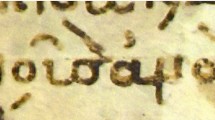Abstract
This is a history of and a technical report on the Charles Harpur Critical Archive (CHCA), which has been in preparation since 2009. Harpur was a predominantly newspaper poet in colonial New South Wales from the 1830s to the 1860s. Approximately 2700 versions of his 700 poems in newspaper and manuscript form have been recovered. In order to manage the complexity of his often heavily revised manuscripts, traditional encoding in XML-TEI, with its known difficulties in handling overlapping structures and complex revisions, was rejected. Instead, the transcriptions were split into simplified versions and layers of revision. Markup describing textual formats was stored externally using properties that may freely overlap. Both markup and the versions and layers were merged into multi-version documents (MVDs) to facilitate later comparison, editing and searching. This reorganisation is generic in design and should be reusable in other editorial projects.



Similar content being viewed by others
Notes
Paul Eggert is project leader and editor of the CHCA (2009–). Desmond Schmidt is the technical lead and programmer (2013–), and Meredith Sherlock served as digital archivist 2009–2016. Other principal contributors include Elizabeth Webby (annotations), Chris Vening (biographical entries) and Michael Falk (qualitative assessments of poems). Loyola University Chicago has provided funding since 2015.
The cut-off date for the project is 1900. The 2700 items include the newspaper and manuscript forms, and a heavily bowdlerised collection in book form arranged by his widow fifteen years after his death. Its texts were the source of future anthologies and most Harpur collections until the 1980s.
See Eggert and Schmidt (2018). Unavoidably there is overlap between the two reports, but their differing emphases have warranted separate treatments.
Sherlock was guided by (but also corrected as necessary) Holt and Perkins (2002).
Intended for archives and scholarly editions, only remnants of it on the Web remain. It was hacked in 2015, effectively destroyed, for there has been no funding available to reinstate it. It was a complicated system that addressed a wide variety of use-cases. It used Drupal as a content management system (CMS) and could deal easily with XML-TEI, although it was in fact agnostic as to the language used. The CHCA now uses a CMS of its own.
The graph in Figure 1 charts the declared response format of 17,103 public APIs (application programming interfaces) of Web services listed in the Programmable Web index (https://www.programmableweb.com/category/all/apis). See also Patrizio 2016 and the URL for his graph at <http://images.techhive.com/images/article/2016/06/stackoverflowqs-100665502-orig.png>.
The xml.org mailing list charts the popularity of XML from its inception in 1997 to the present day. The popular and long-standing slashdot.org news site reports on technical issues including XML from 2001. Since the popularity of Slashdot varied year on year the actual numbers of XML posts have been normalised by expressing them as percentages of the total posts for each year. The values for both Xml.org and Slashdot were expressed as percentages of their most popular year to make them directly comparable.
The separate publication mentioned above (Eggert and Schmidt 2018) reflects further on the distinction between layer and version.
The MVD in fact simplifies the variant graph, into which it may be readily converted or vice versa.
See Pierazzo (2015) on the long-recognised problem of overlapping hierarchies for TEI encoding: ‘the reality is that the problem has no real solution’ (2015, 120).
This is less than two layers per version overall because there are hundreds of newspaper and other printed versions that require only one layer each.
The statistics may change during the editorial phase of the project, due to start after the formal launch of the CHCA in mid 2018.
E.g., ‘Trust in God’ appears on the inside front cover of A87–1 (Mitchell Library, State Library of New South Wales). Its base layer is a second version of what appears on page 109 of the same manuscript book. That base layer appeared in Empire on 20 June 1853; the second layer with some further development (perhaps via a lost subsequent draft) was printed in Australian Home Companion on 5 November 1859. For a theoretical defence of versional editing, see Eggert 2017.
See, e.g., The Jerilderie Letter edition at http://asecentre.org/JITM/index.html, accessed 2 November 2017. Click on Change Settings then on Create Perspective. Just In Time Markup is applied as the perspective is created. Various options are available. The project ceased in 2004 before it had had the benefit of a professional page design; it looks antiquated now.
See, e.g., the discussion by Bauman (2016) of the tortuous handling of end-of-line hyphens in XML. In comparison, when there is no markup in the text (in the CHCA, markup is held as standoff properties) the problems Bauman notes as created by using XML are removed.
References
Bauman, S. (2016, August). The Hard Edges of Soft Hyphens. Paper presented at balisage: The markup conference. Washington DC, USA.
Burnard, L. (2013). Resolving the Durand Conundrum. Journal of the Text Encoding Initiative, 6. https://journals.openedition.org/jtei/842. Accessed 11 May 2019.
Eggert, P. (2016). Charles Harpur: The editorial nightmare. JASAL, 16(2), 1–14. https://openjournals.library.sydney.edu.au/index.php/JASAL/article/view/11011. Accessed 11 May 2019.
Eggert, P. (2017). Versional editing of a romantic poet. Tipofilologia, 10, 11–24.
Eggert, P. (2018a). The Archival Impulse and the Editorial Impulse. Variants, 14, forthcoming.
Eggert, P. (2018b). Ed. The Charles Harpur Critical Archive. http://charles-harpur.org/Home/. Accessed 11 May 2019.
Eggert, P., & Schmidt, D. (2018). Romantic Poetry and Technical Breakthrough: The Charles Harpur Critical Archive. Archiv, 255(1) forthcoming.
Holt, E., & Perkins E. (2002). Eds. The Poems of Charles Harpur in Manuscript in the Mitchell Library and in Publication in the Nineteenth Century: An Analytical Finding List. Canberra: Australian Scholarly Editions Centre.
Patrizio, A. (2016, 9 June). XML Is Toast: Long Live JSON. CIO. DOI: https://www.cio.com/article/3082084/web-development/xml-is-toast-long-live-json.html. Accessed 11 May 2019.
Pierazzo, E. (2015). Digital Scholarly Editing: Theories, Models and Methods. Farnham, Surrey: Ashgate.
Author information
Authors and Affiliations
Corresponding author
Rights and permissions
About this article
Cite this article
Schmidt, D., Eggert, P. The Charles Harpur Critical Archive. Int J Digit Humanities 1, 279–288 (2019). https://doi.org/10.1007/s42803-019-00021-9
Published:
Issue Date:
DOI: https://doi.org/10.1007/s42803-019-00021-9




